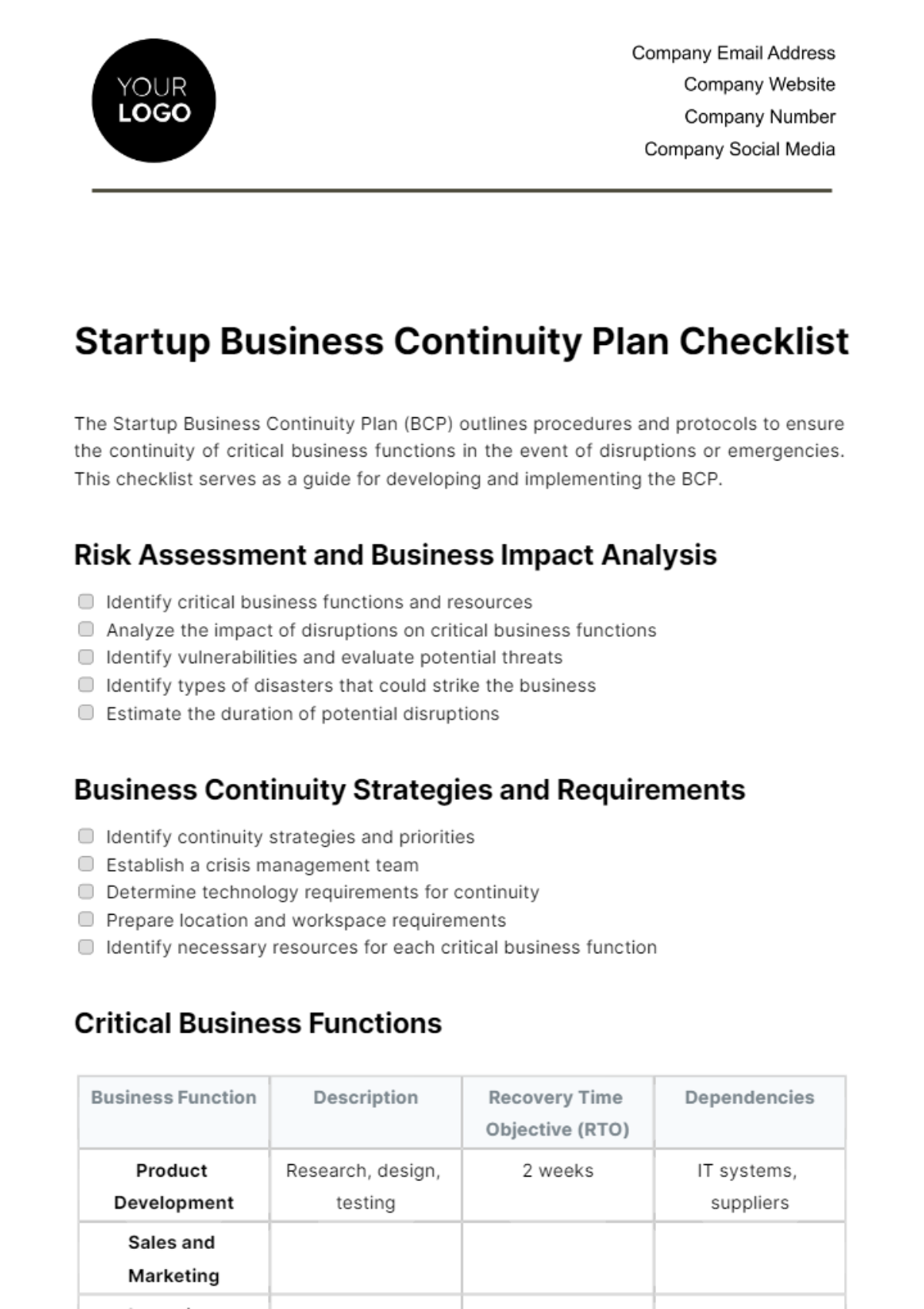Startup Business Continuity Plan
Table of Contents
1. Executive Summary
2. Identifying Risks and Threats
3. Assessing Business Impact
4. Planning Response & Recovery Strategies
5. Emergency Communication Plan
6. Training and Awareness
7. Testing and Reviewing the Plan
8. Continuity Team Composition
9. Insurance Coverage
10. Plan Review and Update
1. Executive Summary
This Business Continuity Plan (BCP) is meticulously crafted to fortify [Your Company Name]'s resilience in the face of unforeseen disruptions. Serving as a comprehensive roadmap, the plan delineates strategic actions and safeguards designed to preserve the integrity of our operations, protect our human and physical assets, and ensure the sustainability of our business model. By adopting a proactive stance towards potential crises, this plan underscores our commitment to continuity, operational excellence, and the long-term prosperity of our startup.
2. Identifying Risks and Threats
Understanding the spectrum of risks that could potentially impact our operations is foundational to our BCP. This involves a systematic evaluation of external and internal threats, ranging from natural disasters, cyber-attacks, supply chain disruptions, to key personnel loss. Leveraging risk assessment tools and methodologies, we aim to prioritize these risks based on their likelihood and potential impact, setting the stage for the development of targeted mitigation strategies.
Risk Categorization: Our approach begins with categorizing risks into natural, technological, and human-induced threats. This categorization helps in tailoring specific strategies for different types of disruptions, ensuring a comprehensive risk management framework.
Risk Category | Description | Example Risks |
|---|---|---|
Natural | Risks arising from natural disasters | Floods, earthquakes, hurricanes |
Technological | Risks related to technology failures | Cyber-attacks, system downtimes |
Human-Induced | Risks caused by human actions or errors | Data breaches, operational mistakes |
Table 1: Risk Categorization
This table categorizes potential risks, aiding in the development of targeted mitigation strategies specific to each type of disruption, thus enhancing our risk management framework's comprehensiveness.
Risk Assessment Tools: We employ a variety of tools, including SWOT analysis (Strengths, Weaknesses, Opportunities, Threats), PESTLE analysis (Political, Economic, Social, Technological, Legal, Environmental), and risk matrices to evaluate and prioritize risks based on their potential impact and probability.
Tool | Purpose | Application in Risk Assessment |
|---|---|---|
SWOT Analysis | To identify internal and external factors impacting the business | Identifying strengths to leverage for mitigating weaknesses and threats, while capitalizing on opportunities |
PESTLE Analysis | To analyze macro-environmental factors | Evaluating how political, economic, social, technological, legal, and environmental factors pose risks to operations |
Risk Matrices | To prioritize risks based on impact and probability | Categorizing risks into high, medium, or low based on their potential impact and likelihood of occurrence |
Table 2: Risk Assessment Tools
This table outlines the tools used in our risk assessment process, illustrating how each contributes to identifying, evaluating, and prioritizing risks.
Stakeholder Involvement: Engaging stakeholders in the risk identification process ensures a broad perspective, capturing risks across all facets of our operations. This collaborative approach enhances the accuracy and comprehensiveness of our risk assessment.
Stakeholder Group | Role in Risk Identification | Contribution |
|---|---|---|
Employees | To provide insights on operational risks | Reporting potential hazards and vulnerabilities in daily operations |
Customers | To highlight service or product risks | Offering feedback on product satisfaction and service continuity concerns |
Suppliers | To identify supply chain risks | Sharing information on potential disruptions in supply or price fluctuations |
Table 3: Stakeholder Involvement
This table showcases the importance of engaging diverse stakeholder groups in the risk identification process. Their contributions ensure a broad perspective, enhancing the accuracy and comprehensiveness of our risk assessment efforts.
3. Assessing Business Impact
Through a detailed Business Impact Analysis (BIA), we scrutinize how different scenarios might affect our essential functions and services. This analysis extends beyond financial implications to consider the effect on our reputation, customer satisfaction, and market position. By identifying critical dependencies and operational thresholds, the BIA informs our prioritization of recovery efforts, ensuring that resources are allocated to protect and restore the most vital areas of our business.
Critical Function Identification: We pinpoint critical business functions and processes essential for our startup's survival. This includes operations that directly impact our customers, regulatory compliance, and our financial health.
Critical Function | Impact on Customers | Impact on Regulatory Compliance | Impact on Financial Health |
|---|---|---|---|
Order Fulfillment | Direct | Low | High |
Customer Support | Direct | Medium | Medium |
Financial Operations | Indirect | High | High |
Table 1: Critical Function Identification
This table identifies the critical business functions essential to our startup's operations, highlighting their impact on key areas such as customer satisfaction, regulatory compliance, and financial health.
Impact Scenarios: For each critical function, we develop impact scenarios, examining the consequences of disruptions ranging from a few hours to several weeks. This helps in understanding the potential severity of different types of interruptions.
Critical Function | Short-term Disruption (Hours-Days) | Medium-term Disruption (Days-Weeks) | Long-term Disruption (Weeks+) |
|---|---|---|---|
Order Fulfillment | Delayed orders, minor customer dissatisfaction | Significant order backlogs, increased customer complaints | Loss of customers, revenue decline |
Customer Support | Increased wait times, slight customer frustration | Inability to resolve issues promptly, worsening customer satisfaction | Permanent damage to customer relationships, brand reputation harm |
Financial Operations | Minor delays in financial transactions | Significant delays in billing and payments, cash flow issues | Severe financial instability, potential regulatory penalties |
Table 2: Impact Scenarios
This table outlines potential scenarios for each critical function, detailing the consequences of disruptions over varying durations, thereby aiding in understanding the severity and potential impact of interruptions.
Prioritization of Recovery Efforts: Based on the BIA, we prioritize recovery efforts, focusing first on restoring functions that are most critical to our operational continuity and stakeholder commitments. This ensures efficient resource allocation during recovery operations.
Critical Function | Recovery Priority | Justification | Recovery Time Objective (RTO) |
|---|---|---|---|
Financial Operations | High | Financial stability is paramount for operational continuity and compliance | 24-48 hours |
Order Fulfillment | Medium | Directly impacts customer satisfaction and revenue, but short-term disruptions are manageable | 72 hours |
Customer Support | Low | Essential for maintaining customer relations, but temporary alternatives can mitigate impact | 1 week |
Table 3: Prioritization of Recovery Efforts
This table prioritizes the recovery efforts for each critical function based on the Business Impact Analysis, focusing on restoring the most vital operations first to ensure efficient resource allocation during recovery. Justifications for each priority level and Recovery Time Objectives (RTOs) are provided to guide the recovery process.
4. Planning Response & Recovery Strategies
For each identified risk, bespoke response and recovery strategies are formulated, detailing immediate actions and longer-term recovery plans. This includes establishing incident management teams, defining critical path recovery processes, and setting clear recovery time objectives (RTOs). Our strategies are rooted in agility and flexibility, allowing for rapid adaptation as situations evolve, ensuring the quickest possible return to operational normalcy.
Incident Response Team: Establishment of an Incident Response Team (IRT) tasked with immediate action and coordination during a crisis. This team is equipped with clear protocols and authority to make critical decisions swiftly.
Role | Member Name | Responsibilities | Authority Level |
|---|---|---|---|
Team Leader | [Name] | Overall coordination of the response efforts | High |
Communications Officer | [Name] | Managing all external and internal communications | Medium |
IT Specialist | [Name] | Ensuring IT systems' integrity and recovery | Medium |
HR Representative | [Name] | Employee welfare and communication | Medium |
Operations Manager | [Name] | Overseeing the restoration of operations | High |
Table 1: Incident Response Team (IRT) Composition
This table outlines the structure of the IRT, detailing roles, member assignments, key responsibilities, and their authority levels to make critical decisions rapidly during a crisis.
Recovery Time Objectives (RTOs): For each critical function, we establish RTOs, setting explicit targets for the time to resume operations post-disruption. This ensures a focused recovery effort and sets clear expectations for stakeholders.
Critical Function | RTO | Justification |
|---|---|---|
Order Fulfillment | 24 hours | Essential for customer satisfaction and revenue generation |
IT Systems | 12 hours | Critical for operational functionality and data access |
Customer Support | 48 hours | Important for maintaining customer trust and relations |
Table 2: Recovery Time Objectives (RTOs)
This table specifies the RTOs for each critical function, providing clear targets for the time to resume operations post-disruption. It includes justifications for each RTO, ensuring stakeholders understand the prioritization of recovery efforts.
Business Recovery Sites: Identifying alternate business recovery sites and remote work options to ensure business operations can continue uninterrupted in the event the primary site is inaccessible or compromised.
Function | Primary Site Location | Recovery Site Location | Remote Work Option |
|---|---|---|---|
Headquarters | [City, Address] | [Alternate City, Address] | Yes |
Data Center | [City, Address] | [Cloud-based Solutions] | Not Applicable |
Customer Support Center | [City, Address] | [Alternate City, Address] | Yes |
Table 3: Business Recovery Sites
This table identifies alternate recovery sites and remote work options for different business functions, ensuring that operations can continue uninterrupted if the primary site is compromised or inaccessible.
5. Emergency Communication Plan
A robust communication framework is essential for effective crisis management. Our emergency communication plan specifies protocols for internal and external communications, designating spokespersons, and leveraging various channels to reach stakeholders efficiently. By maintaining transparency and providing timely updates, we aim to uphold trust and confidence among employees, customers, partners, and the broader community during critical periods.
Communication Channels: Outlining multiple communication channels, including email, social media, SMS, and emergency notification systems, to ensure redundancy and reliability in crisis communication.
Channel | Purpose | Advantages | Limitations |
|---|---|---|---|
Formal communication with stakeholders | Documented, wide reach | May not be immediately seen | |
Social Media | Updates and public announcements | Fast, wide reach, interactive | Requires constant monitoring |
SMS | Urgent alerts and updates | Immediate, high open rates | Limited information capacity |
Emergency Notification Systems | Direct alerts to employees and stakeholders | Customizable, can target specific groups | Setup and maintenance costs |
Table 1: Communication Channels
This table outlines the communication channels [Your Company Name] will utilize during a crisis, highlighting their purposes, advantages, and limitations to ensure a diverse and effective communication strategy.
Stakeholder Mapping: Developing a stakeholder communication plan, identifying key messages for employees, customers, suppliers, and other critical stakeholders to ensure timely and accurate information dissemination.
Stakeholder Group | Key Messages | Preferred Channels | Frequency/Trigger |
|---|---|---|---|
Employees | Safety procedures, operational updates | Email, SMS, Emergency Notification Systems | As needed/Immediately upon incident |
Customers | Service continuity, support availability | Social Media, Email | Regular updates during crisis |
Suppliers | Inventory needs, logistical changes | Email, Direct Calls | Pre-crisis and as situation evolves |
Regulatory Bodies | Compliance status, impact assessments | Email, Official Reports | As required by regulations |
Table 2: Stakeholder Mapping
This table provides a strategic overview of the communication plan for key stakeholder groups, detailing the core messages, preferred communication channels, and the timing or triggers for communication.
Crisis Communication Training: Providing specialized training for designated spokespersons and the IRT on crisis communication best practices to ensure coherent and calm communication during emergencies.
Training Component | Audience | Objectives | Methodology |
|---|---|---|---|
Best Practices | Spokespersons, IRT | To equip with skills for clear, accurate messaging | Workshops, Simulated Scenarios |
Media Handling | Spokespersons | To prepare for media inquiries and public statements | Role-playing, Media Interaction Exercises |
Psychological First Aid | All Employees | To provide support and communication in a crisis | Online Courses, In-person Training |
Table 3: Crisis Communication Training
This table delineates the components of the crisis communication training program at [Your Company Name], identifying the target audiences, training objectives, and methodologies employed to ensure effective and coherent communication during emergencies.
6. Training and Awareness
Ensuring that our team is well-prepared to execute the BCP is critical. Comprehensive training programs and regular awareness campaigns are designed to embed business continuity principles into our corporate culture. Simulation exercises and drills will be conducted periodically to test readiness and reinforce the practical application of the plan, fostering a workplace that is resilient and responsive to disruptions.
Business Continuity Training Programs: Implementing comprehensive training programs that cover the BCP's key aspects, ensuring all employees understand their roles and responsibilities within the plan.
Training Program | Target Audience | Objectives | Delivery Method |
|---|---|---|---|
BCP Overview | All Employees | To provide a general understanding of the BCP, its importance, and goals. | Webinar, Online Modules |
Role-Specific Training | Designated Response Teams | To detail specific roles and responsibilities within the BCP. | In-person Workshops |
Decision-Making Under Pressure | Incident Response Team (IRT) | To enhance decision-making skills in crisis situations. | Simulation Exercises |
Table 1: Business Continuity Training Programs
This table outlines the structured approach to equipping [Your Company Name]'s workforce with the knowledge and skills necessary to effectively enact the Business Continuity Plan.
Awareness Campaigns: Conducting regular awareness campaigns to keep business continuity practices top of mind for all employees. This includes newsletters, intranet posts, and informational sessions.
Campaign Element | Description | Target Audience | Frequency |
|---|---|---|---|
Newsletters | Updates on BCP initiatives and improvements. | All Employees | Quarterly |
Intranet Posts | Tips on personal preparedness and BCP highlights. | All Employees | Monthly |
Informational Sessions | Live sessions to discuss BCP components and Q&A. | All Employees | Semi-annually |
Table 2: Awareness Campaigns
This table captures the ongoing efforts to maintain a high level of BCP awareness among all employees at [Your Company Name], ensuring continuous engagement and understanding of business continuity practices.
Simulation Exercises: Organizing regular drills and simulation exercises to test the plan's effectiveness and staff readiness. These exercises range from tabletop exercises to full-scale drills involving external agencies.
Exercise Type | Description | Target Audience | Frequency |
|---|---|---|---|
Tabletop Exercises | Scenario-based discussions to walkthrough BCP responses. | IRT and Key Staff | Annually |
Full-Scale Drills | Physical drills simulating a disaster to test the BCP's practical application. | All Employees | Bi-annually |
Agency Collaboration Drills | Joint exercises with external agencies to coordinate broader response efforts. | IRT and External Agencies | Every 2 Years |
Table 3: Simulation Exercises
This table delineates the types of simulation exercises [Your Company Name] conducts to ensure readiness and effective BCP implementation. These exercises range in complexity and involvement, from internal discussions to collaborative drills with external entities.
7. Testing and Reviewing the Plan
The efficacy of the BCP is contingent upon rigorous testing and continuous improvement. Through simulated scenarios and real-world exercises, we evaluate the plan's effectiveness, identifying areas for refinement. Post-exercise reviews facilitate the integration of lessons learned into the plan, with revisions made to enhance our preparedness and response capabilities.
Testing Schedule: Establishing a regular schedule for testing the BCP, including annual tabletop exercises and bi-annual full-scale drills, to ensure the plan remains effective and relevant.
Test Type | Description | Frequency | Target Participants |
|---|---|---|---|
Tabletop Exercises | Discussion-based simulations of potential disruptions to walkthrough the BCP response. | Annually | Incident Response Team, Key Staff |
Full-Scale Drills | Realistic drills that simulate emergency scenarios to test the practical application of the BCP. | Bi-annually | All Employees |
Agency Collaboration Drills | Joint exercises with external agencies to enhance coordination and response efforts. | Every 2 Years | Incident Response Team, External Agencies |
Table 1: Testing Schedule
This table outlines a structured approach to regularly testing [Your Company Name]'s BCP, ensuring that all employees and relevant stakeholders are prepared and the plan's effectiveness is continuously validated.
After-Action Reviews: Conducting thorough after-action reviews following each test or actual incident to identify lessons learned and areas for improvement. This includes soliciting feedback from all participants and stakeholders involved.
Activity Type | Purpose | Process | Participants |
|---|---|---|---|
After-Action Reviews | To evaluate the execution of BCP tests and real incidents, identifying strengths and areas for improvement. | Collect feedback through surveys, interviews, and debrief meetings. Analyze outcomes to document lessons learned. | All Test Participants, Incident Response Team, External Agencies (if involved) |
Table 2: After-Action Reviews
This table captures the essential process of conducting after-action reviews, a critical step in learning from both simulated exercises and actual emergency events. It ensures that constructive feedback is systematically gathered and analyzed to enhance the BCP.
Plan Updates: Regularly updating the BCP based on the outcomes of tests and reviews, changes in the business environment, or operational changes within the company. This ensures the plan evolves in line with [Your Company Name]'s needs and the external risk landscape.
Update Trigger | Description | Update Process | Responsibility |
|---|---|---|---|
Test and Review Outcomes | Insights from testing and after-action reviews indicating areas for plan refinement. | Incorporate lessons learned into the BCP. Adjust strategies and protocols as necessary. | Business Continuity Manager |
Business Environment Changes | Significant shifts in the external business landscape, such as new regulatory requirements or market conditions. | Review and adjust the BCP to ensure alignment with current operational realities and external demands. | Executive Leadership, Legal Team |
Operational Changes | Internal changes within [Your Company Name], such as expansions, new technologies, or process modifications. | Update the BCP to reflect new operations, ensuring continuity strategies remain relevant and comprehensive. | Department Heads, IT Man |
Table 3: Plan Updates
This table outlines the triggers and processes for regularly updating the BCP, ensuring that it remains a living document that accurately reflects [Your Company Name]'s current operational, environmental, and regulatory context.
8. Continuity Team Composition
Our Business Continuity Team (BCT) is composed of cross-functional leaders empowered to steer the implementation and ongoing management of the BCP. This section outlines the structure of the BCT, delineating roles, responsibilities, and the hierarchical command chain to ensure decisive leadership and coordinated action during a crisis.
Role | Name | Responsibilities | Authority Level | Contact Information |
|---|---|---|---|---|
BCT Leader | [Leader's Name] | Overall leadership of BCT, decision-making, and communication with executive management. | High | [Contact Info] |
Operations Lead | [Name] | Coordinates operational continuity efforts, liaises with department heads. | Medium | [Contact Info] |
IT Recovery Lead | [Name] | Oversees restoration of IT systems and cybersecurity measures. | Medium | [Contact Info] |
Communications Officer | [Name] | Manages all internal and external communications, public relations during a crisis. | Medium | [Contact Info] |
HR Coordinator | [Name] | Addresses staff welfare, remote work coordination, and personnel communication. | Medium | [Contact Info] |
Finance Coordinator | [Name] | Manages financial aspects, insurance claims, and cash flow management during disruptions. | Medium | [Contact Info] |
Facilities Coordinator | [Name] | Ensures physical site security, utility management, and alternative site readiness. | Medium | [Contact Info] |
Supply Chain Coordinator | [Name] | Coordinates with suppliers and logistics to ensure supply chain continuity. | Medium | [Contact Info] |
Legal Advisor | [Name] | Provides legal guidance, ensures compliance with regulatory requirements during recovery. | Medium | [Contact Info] |
9. Insurance Coverage
Mitigating financial exposure through strategic insurance coverage is an integral component of our continuity planning. We evaluate and secure comprehensive policies that align with our risk profile, covering aspects such as property damage, cyber liability, and business interruption. This financial preparedness is instrumental in cushioning the startup against potential losses and facilitating a smoother recovery process.
Insurance Type | Coverage Limit | Key Aspects Covered | Provider |
|---|---|---|---|
Property Damage | $1,000,000 | Building, equipment, inventory | [Provider Name] |
Cyber Liability | $500,000 | Data recovery, legal fees, customer notification | [Provider Name] |
Business Interruption | $750,000 per event | Operating expenses, payroll, lost income | [Provider Name] |
General Liability | $1,000,000 per occurrence | Customer injuries, property damages, advertising injuries | [Provider Name] |
Workers' Compensation | State-mandated limits | Employee medical care, rehabilitation, lost wages | [Provider Name] |
Key Person Insurance | $500,000 per key person | Losses due to the absence of key personnel, recruitment, and training costs | [Provider Name] |
10. Plan Review and Update
Recognizing the dynamic nature of our operating environment, the BCP is subject to regular reviews and updates. This iterative process ensures that the plan remains aligned with our evolving business model, operational practices, and the external risk landscape. Scheduled reviews, coupled with ad-hoc updates following significant changes or incidents, guarantee that our continuity planning is current, relevant, and capable of safeguarding [Your Company Name]'s future.
Review Type | Frequency | Trigger Events | Responsible Party | Review Process |
|---|---|---|---|---|
Scheduled Review | Annually | N/A | Business Continuity Manager | Comprehensive review of the entire BCP for relevance and effectiveness. |
Ad-Hoc Update | As Needed | Significant operational changes, new risks identified, after an incident | Business Continuity Team | Targeted updates to address specific changes or lessons learned from incidents. |









































